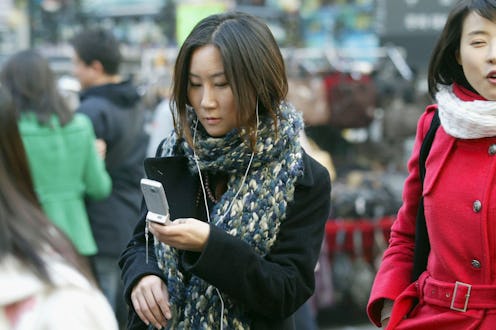News
A Cell Phone Lane? Hey, That Makes Sense...
In the country that boasts the world's largest population and fastest growing economy, innovation is bound to run rampant. After all, with nearly 20 percent of the world's population, China is sure to be the ones to solve our society's problems, one of the most pressing of which is the dangerous clumsiness of those who walk and text at the same time (guilty as charged). And to address this issue, the city of Chongqing, China has set up a "cellphone lane" to segregate cellphone wielding pedestrians from normal pedestrians. Sure, you may laugh, but with nearly 1.5 billion people in China, controlling traffic is a serious issue.
The "no cellphone lane" is a mere 100 feet long and about 6 feet wide, so the non-texting-and-walking population of China doesn't have very much real estate to work with. But for those 600 square feet, thet can expect to be saved from the inevitable bumps and run-ins that result from thumbs moving in tandem with feet. The sidewalk is delineated by a series of white painted lines, clearly demarcating the boundaries of each respective group.
A sign, painted on the ground (where, obviously, cellphone users will be looking), reads, "Cell phone users walk in this lane at your own risk." Another sign, this one propped upright, notes that this is the "first mobile phone sidewalks in China."
Nong Cheng, who works in marketing at the Meixin Group, the organization in charge of Chongqing's entertainment zone where the sidewalk is located, told the Associated Press,
There are lots of elderly people and children in our street, and walking with your cellphone may cause unnecessary collisions here.
Besides being a danger to others, walking texters are also a hazard to themselves, as evidenced by the numerous videos of people falling into fountains. Also, the far less entertaining reports of serious injuries caused by cellphone users who unwittingly walk into traffic while absorbed on their phones.
Of course, given the general state of oblivion that most cellphone users seem to be in while traveling from point A to point B, it's unclear as to how effective this cellphone lane will be. In fact, just a few months ago, a TV crew in Washington, DC set up a similar experiment, and for one day, created a no cellphone lane on one of the city's sidewalks.
Unfortunately, for the most part, the "no cellphone" signs were largely ignored, or perhaps simply missed by those too engrossed by emails, texts, and cat videos. After all, why just walk if you can walk and catch up on everything you missed in the five minutes you didn't have your phone?
Another reason that this no cellphone lane thing might not be taken to heart is that the sidewalk's location isn't exactly in the most serious of places — positioned on Foreigner Street, a highly touristy area known for its "faux Western architecture and an amusement park," the street also boasts the world's largest bathroom.
And as cheeky as the sidewalk idea is, some citizens aren't taking too kindly to the idea of being told where they can and cannot use their phones. As one pedestrian named Xing Xing told the China Daily, "This kind of sidewalk is not a fundamental solution and could be an indulgence for mobile phone addicts in the long run, in my mind, and this could even lead to more problems in the future."
But regardless of whether or not these sidewalk lanes are a viable longterm solution, China may soon be truly in need of a short-term answer to a booming mobile phone network. In fact, the China Daily estimates that by the end of the year, there will be 500 million smartphones in play in the nation, which means that over a third of the population will have some sort of Internet connected mobile device.
What's more, China's growing population (as well as the populations of other countries), seems to be suffering from a phenomenon known as "sidewalk rage," which is effectively road rage without the cars. Jerry Deffenbacher, a professor at Colorado State University who specializes in anger and road rage, told the Wall Street Journal, "A lot of us have "shoulds" in our head. Ragers tend to think people should do things their way, and get angry because the slow walkers are breaking the rules of civility. It's unclear exactly why some people harbor such beliefs."
He continued,
Ragers' thoughts tend to be overly negative, over-generalized and blown out of proportion, leaving them fuming about how they can't stand the situation, how late they are going to be, and how this always comes up. In contrast, someone blissfully free of sidewalk rage may still be frustrated, but thinks more accepting thoughts such as, "This is the way life is sometimes" or, "I wish that slow person wasn't in front of me."
While it is unclear how separating the cellphone users from the sidewalk ragers will affect these issues, it certainly seems like a step in the right direction. You never know — you just might see cellphone lanes joining bike lanes in New York City one of these days.
Images: ChineseCurrents, dpontefract/Twitter; Getty Images
